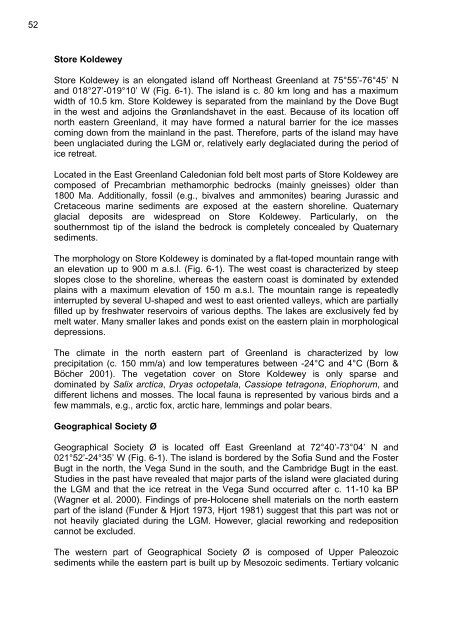the Expedition ARKTIS-XIX/4 of the research vessel POLARSTERN ...
the Expedition ARKTIS-XIX/4 of the research vessel POLARSTERN ...
the Expedition ARKTIS-XIX/4 of the research vessel POLARSTERN ...
You also want an ePaper? Increase the reach of your titles
YUMPU automatically turns print PDFs into web optimized ePapers that Google loves.
52<br />
Store Koldewey<br />
Store Koldewey is an elongated island <strong>of</strong>f Nor<strong>the</strong>ast Greenland at 75°55’-76°45’ N<br />
and 018°27’-019°10’ W (Fig. 6-1). The island is c. 80 km long and has a maximum<br />
width <strong>of</strong> 10.5 km. Store Koldewey is separated from <strong>the</strong> mainland by <strong>the</strong> Dove Bugt<br />
in <strong>the</strong> west and adjoins <strong>the</strong> Grønlandshavet in <strong>the</strong> east. Because <strong>of</strong> its location <strong>of</strong>f<br />
north eastern Greenland, it may have formed a natural barrier for <strong>the</strong> ice masses<br />
coming down from <strong>the</strong> mainland in <strong>the</strong> past. Therefore, parts <strong>of</strong> <strong>the</strong> island may have<br />
been unglaciated during <strong>the</strong> LGM or, relatively early deglaciated during <strong>the</strong> period <strong>of</strong><br />
ice retreat.<br />
Located in <strong>the</strong> East Greenland Caledonian fold belt most parts <strong>of</strong> Store Koldewey are<br />
composed <strong>of</strong> Precambrian methamorphic bedrocks (mainly gneisses) older than<br />
1800 Ma. Additionally, fossil (e.g., bivalves and ammonites) bearing Jurassic and<br />
Cretaceous marine sediments are exposed at <strong>the</strong> eastern shoreline. Quaternary<br />
glacial deposits are widespread on Store Koldewey. Particularly, on <strong>the</strong><br />
sou<strong>the</strong>rnmost tip <strong>of</strong> <strong>the</strong> island <strong>the</strong> bedrock is completely concealed by Quaternary<br />
sediments.<br />
The morphology on Store Koldewey is dominated by a flat-toped mountain range with<br />
an elevation up to 900 m a.s.l. (Fig. 6-1). The west coast is characterized by steep<br />
slopes close to <strong>the</strong> shoreline, whereas <strong>the</strong> eastern coast is dominated by extended<br />
plains with a maximum elevation <strong>of</strong> 150 m a.s.l. The mountain range is repeatedly<br />
interrupted by several U-shaped and west to east oriented valleys, which are partially<br />
filled up by freshwater reservoirs <strong>of</strong> various depths. The lakes are exclusively fed by<br />
melt water. Many smaller lakes and ponds exist on <strong>the</strong> eastern plain in morphological<br />
depressions.<br />
The climate in <strong>the</strong> north eastern part <strong>of</strong> Greenland is characterized by low<br />
precipitation (c. 150 mm/a) and low temperatures between -24°C and 4°C (Born &<br />
Böcher 2001). The vegetation cover on Store Koldewey is only sparse and<br />
dominated by Salix arctica, Dryas octopetala, Cassiope tetragona, Eriophorum, and<br />
different lichens and mosses. The local fauna is represented by various birds and a<br />
few mammals, e.g., arctic fox, arctic hare, lemmings and polar bears.<br />
Geographical Society Ø<br />
Geographical Society Ø is located <strong>of</strong>f East Greenland at 72°40’-73°04’ N and<br />
021°52’-24°35’ W (Fig. 6-1). The island is bordered by <strong>the</strong> S<strong>of</strong>ia Sund and <strong>the</strong> Foster<br />
Bugt in <strong>the</strong> north, <strong>the</strong> Vega Sund in <strong>the</strong> south, and <strong>the</strong> Cambridge Bugt in <strong>the</strong> east.<br />
Studies in <strong>the</strong> past have revealed that major parts <strong>of</strong> <strong>the</strong> island were glaciated during<br />
<strong>the</strong> LGM and that <strong>the</strong> ice retreat in <strong>the</strong> Vega Sund occurred after c. 11-10 ka BP<br />
(Wagner et al. 2000). Findings <strong>of</strong> pre-Holocene shell materials on <strong>the</strong> north eastern<br />
part <strong>of</strong> <strong>the</strong> island (Funder & Hjort 1973, Hjort 1981) suggest that this part was not or<br />
not heavily glaciated during <strong>the</strong> LGM. However, glacial reworking and redeposition<br />
cannot be excluded.<br />
The western part <strong>of</strong> Geographical Society Ø is composed <strong>of</strong> Upper Paleozoic<br />
sediments while <strong>the</strong> eastern part is built up by Mesozoic sediments. Tertiary volcanic

















